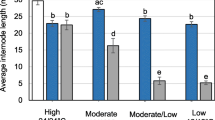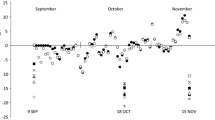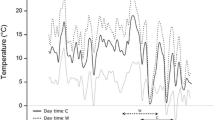Abstract
All plant species reach a low temperature range limit when either low temperature extremes exceed their freezing tolerance or when their metabolism becomes too restricted. In this study, we explore the ultimate thermal limit of plant tissue formation exemplified by a plant species that seemingly grows through snow. By a combination of studies in alpine snowbeds and under controlled environmental conditions, we demonstrate and quantify that the clonal herb Soldanella pusilla (Primulaceae) does indeed grow its entire flowering shoot at 0 °C. We show that plants resume growth under 2–3 m of snow in mid-winter, following an internal clock, with the remaining period under snow until snow melt (mostly in July) sufficient to produce a flowering shoot that is ready for pollination. When snow pack gets thin, the flowering shoot intercepts and re-radiates long-wave solar radiation, so that snow and ice gently melt around the fragile shoot and the flowers emerge without any mechanical interaction. We evidence bud preformation in the previous season and enormous non-structural carbohydrate reserves in tissues (mainly below ground) in the form of soluble sugars (largely stachyose) that would support basic metabolism for more than 2 entire years under snow. However, cell-wall formation at 0 °C appears to lack unknown strengthening factors, including lignification (assessed by confocal Raman spectroscopy imaging) that require between a few hours or a day of warmth after snow melt to complete tissue strengthening. Complemented with a suite of anatomical data, the work opens a window towards understanding low temperature limits of plant growth in general, with potential relevance for winter crops and trees at the natural climatic treeline.












Similar content being viewed by others
References
Abdrakhamanova A, Wang QY, Khokhlova L, Nick P (2003) Is microtubule disassembly a trigger for cold acclimation? Plant Cell Phys 44:676–686
Alvarez-Uria P, Körner C (2007) Low temperature limits of root growth in deciduous and evergreen temperate tree species. Funct Ecol 21:211–218
Benkeblia N, Ueno K, Onodera S, Shiomi N (2005) Variation of fructooligosaccharides and their metabolizing enzymes in onion bulb (Allium cepa L. cv. Tenshin) during long-term storage. J Food Sci 70:208–214
Billings WD, Bliss LC (1959) An alpine snowbank environment and its effects on vegetation, plant development, and productivity. Ecology 40:388–397
Billings WD, Shaver GR, Trent AW (1976) Measurement of root growth in simulated and natural temperature gradients over permafrost. Arctic Alp Res 8:247–250
Chope GA, Cools K, Hammond JP, Thompson AJ, Terry LA (2012) Physiological, biochemical and transcriptional analysis of onion bulbs during storage. Ann Bot 109:819–831
De Witte LC, Armbruster GFJ, Gielly L, Taberlet P, Stocklin J (2012) AFLP markers reveal high clonal diversity and extreme longevity in four key arctic-alpine species. Mol Ecol 21:1081–1097
Dey PM, Haborne JB (1997) Plant biochemistry. Academic Press, London, p 554
Donaldson LA (2001) Lignification and lignin topochemistry—an ultrastructural view. Phytochemistry 57:859–873
Fenner M (1985) Seed ecology. Chapman and Hall, London
Ferreira BG, Falcioni R, Guedes LM, Avritzer SC, Antunes WC, Souza LA, Isaias MS (2017) Preventing false negatives for histochemical detection of phenolics and lignines in PEG-embedded plant tissues. J Histochem Cytochem 65:105–116
Gierlinger N, Keplinger T, Harrington M (2012) Imaging of plant cell walls by confocal Raman microscopy. Nat Protoc 7:1694–1708
Green K, Pickering C (2009) Vegetation, microclimate and soils associated with the latest-lying snowpatches in Australia. Plant Ecol Divers 2:289–300
Grime JP, Mowforth MA (1982) Variation in genome size—an ecological interpretation. Nature 299:151–153
Hartmann H (1957) Studien über die vegetative Fortpflanzung in den Hochalpen. Jahresber Naturf Ges Graubündens 86:3–168
Hoch G, Popp M, Körner C (2002) Altitudinal increase of mobile carbon pools in Pinus cembra suggests sink limitation of growth at the Swiss treeline. Oikos 98:361–374
Inauen N, Körner C, Hiltbrunner E (2012) No growth stimulation by CO2 enrichment in alpine glacier forefield plants. Glob Change Biol 18:985–999
Inoue K, Araki T, Endo M (2018) Circadian clock during plant development. J Plant Res 131:59–66
Körner C (2003) Alpine plant life, 2nd edn. Springer, Berlin
Körner C (2006) Significance of temperature in plant life. In: Morison JIL, Morecroft MD (eds) Plant growth and climate change. Blackwell Publishing Ltd, Oxford, pp 48–69
Körner C (2008) Winter crop growth at low temperature may hold the answer for alpine treeline formation. Plant Ecol Divers 1:3–11
Körner C (2011) Coldest places on earth with angiosperm plant life. Alp Bot 121:11–22
Körner C, Diemer M (1987) In situ photosynthetic responses to light, temperature and carbon dioxide in herbaceous plants from low and high altitude. Funct Ecol 1:179–194
Körner C, Hiltbrunner E (2018) The 90 ways to describe plant temperature. Persp Plant Ecol Evol Syst 30:16–21
Körner C, Pelaez Menendez-Riedl S (1989) The significance of developmental aspects in plant growth analysis. In: Lambers H, Cambridge ML, Konings H, Pons TL (eds) Causes and consequences of variation in growth rate and productivity of higher plants. SPB Acad Publ, The Hague, pp 141–157
Körner C, Woodward FI (1987) The dynamics of leaf extension in plants with diverse altitudinal ranges. 2. Field studies in Poa species between 600 and 3200 m altitude. Oecologia 72:279–283
Körner C, Leuzinger S, Riedl S, Siegwolf RT, Streule L (2016) Carbon and nitrogen stable isotope signals for an entire alpine flora, based on herbarium samples. Alp Bot 126:153–166
Ladinig U, Hacker J, Neuner G, Wagner J (2013) How endangered is sexual reproduction of high-mountain plants by summer frosts? Frost resistance, frequency of frost events and risk assessment. Oecologia 171:743–760
Larcher W, Kainmüller C, Wagner J (2010) Survival types of high mountain plants under extreme temperatures. Flora 205:3–18
Larigauderie A, Körner C (1995) Acclimation of leaf dark respiration to temperature in alpine and lowland plant species. Ann Bot 76:245–252
Li X, Rossi S, Liang E, Camarero JJ (2016) Temperature thresholds for the onset of xylogenesis in alpine shrubs on the Tibetan Plateau. Trees 30:2091–2099
Ligrone R, Carafa A, Duckett JG, Renzaglia KS, Ruel K (2008) Immunocytochemical detection of lignin-related epitopes in cell walls in bryophytes and the charalean alga Nitella. Plant Syst Evol 270:257–272
Lovejoy C, Vincent WF, Bonilla S, Roy S, Martineau M-J, Terrado R, Potvin M, Massana R, Pedros-Alio C (2007) Distribution, phylogeny, and growth of cold adapted Picoprasinophytes in Arctic seas. J Phycol 43:78–89
Luterbacher J, Pfister C (2015) The year without a summer. Nat Geosci 8:246–248
Merchant A, Richter A, Popp M, Adams M (2006) Targeted metabolite profiling provides a functional link among eucalypt taxonomy, physiology and evolution. Phytochemistry 67:402–408
Molau U (1993) Relationships between flowering phenology and life history strategies in tundra plants. Arctic Alp Res 25:391–402
Müller T, Leya T, Fuhr G (2001) Persistent snow algal fields in Spitsbergen: field observations and a hypothesis about the annual cell circulation. Arct Antarct Alp Res 33:42–51
Nagelmüller S, Hiltbrunner E, Körner C (2016) Critically low soil temperatures for root growth and root morphology in three alpine plant species. Alpine Bot 126:11–21
Nagelmüller S, Hiltbrunner E, Körner C (2017) Low temperature limits for root growth in alpine species are set by cell differentiation. AoB Plants 9:plx054. https://doi.org/10.1093/aobpla/plx054
Onipchenko VG, Makarov MI, van Logtestijn RSP, Ivanov VB, Akhmetzhanova AA, Tekeev DK, Ermak AA, Salpagarova FS, Kozhevnikova AD, Cornelissen JHC (2009) New nitrogen uptake strategy: specialized snow roots. Ecol Lett 12:758–764
Onipchenko VG, Kipkeev AM, Makarov MI, Kozhevnikova AD, Ivanov VB, Soudzilovskaia NA, Tekeev DK, Salpagarova FS, Werger MJA, Cornelissen JHC (2014) Digging deep to open the white black box of snow root phenology. Ecol Res 29:529–534
Penfield S (2008) Temperature perception and signal transduction in plants. New Phytol 179:615–628
Pesquet E, Zhang B, Gorzsas A, Puhakainen T, Serk H, Escamez S, Barbier O, Gerber L, Courtois-Moreau C, Alatalo E, Paulin L, Kangasjarvi J, Sundberg B, Goffner D, Tuominen H (2013) Non-cell-autonomous postmortem lignification of tracheary elements in Zinnia elegans. Plant Cell 25:1314–1328
Plohovska SG, Yemets AI, Blume YB (2016) Influence of cold on organization of actin filaments of different types of root cells in Arabidopsis thaliana. Cytol Genet 50:318–323
Quentin AG, Pinkard EA, Ryan MG, Tissue DT et al (2015) Non-structural carbohydrates in woody plants compared among laboratories. Tree Physiol 35:1146–1165
Richardson SG, Salisbury FB (1977) Plant responses to the light penetrating snow. Ecology 58:1152–1158
Schäppi B, Körner C (1996) Growth responses of an alpine grassland to elevated CO2. Oecologia 105:43–52
Schenker G, Lenz A, Körner C, Hoch G (2014) Physiological minimum temperatures for root growth in seven common European broad-leaved tree species. Tree Physiol 34:302–313
Scherrer D, Körner C (2009) Infra-red thermometry of alpine landscapes challenges climatic warming projections. Glob Change Biol 16:2602–2613
Scherrer D, Körner C (2011) Topographically controlled thermal-habitat differentiation buffers alpine plant diversity against climate warming. J Biogeogr 38:406–416
Steffen S, Kadereit JW (2014) Parallel evolution of flower reduction in two alpine Soldanella species (Primulaceae). Bot J Linn Soc 175:409–422
Steinacher G, Wagner J (2012) Effect of temperature on the progamic phase in high-mountain plants. Plant Biol 14:295–305
Steinacher G, Wagner J (2013) The progamic phase in high-mountain plants: from pollination to fertilization in the cold. Plants 2:354–370
Wright JC (2001) Cryptobiosis 300 years on from van Leuwenhoek: what have we learned about tardigrades? Zool Anzeig/J Comp Zool 240:563–582
Yang Y, Siegwolf RTW, Körner C (2015) Species specific and environment induced variation of δ13C and δ15N in alpine plants. Front Plant Sci 6:Article 423
YouTube (2019) Movie: ‘Pollination of Soldanella’. https://www.youtube.com/watch?v=deEbgFkMVoE&feature=youtu.be
Zhang L-B, Kadereit JW (2003) The systematics of Soldanella (Primulaceae) based on morphological and molecular (ITS, AFLPs) evidence. Nord J Bot 22:129–169
Acknowledgements
We thank Sandra Schmid for carbohydrate (NSC) analysis in the lab, Patrick Möhl and Sven Trecco for field assistance and Rolf Siegwolf (PSI, Brugg, Switzerland) for mass-spectrometer data. The Alpine Research and Education Station (ALPFOR) on Furka Pass provided the essential local infrastructure.
Author information
Authors and Affiliations
Contributions
CK designed the study, conducted the field- and phytotron-work, and wrote the manuscript. EH helped with field work, provided macro-photographs, and contributed to the manuscript. SR conducted the light microscopy work and contributed the artwork. TK provided Raman spectroscopy scans, which would not have been possible unless FS managed to obtain microtome cuts of unembedded stem tissue and he verified lignification histochemically. AR and JW provided chromatography data for Table 3.
Corresponding author
Ethics declarations
Conflict of interest
The authors declare that they have no conflict of interest.
Ethical standards
The work for this paper meets all ethical standards.
Additional information
Publisher's Note
Springer Nature remains neutral with regard to jurisdictional claims in published maps and institutional affiliations.
Electronic supplementary material
Below is the link to the electronic supplementary material.
Rights and permissions
About this article
Cite this article
Körner, C., Riedl, S., Keplinger, T. et al. Life at 0 °C: the biology of the alpine snowbed plant Soldanella pusilla. Alp Botany 129, 63–80 (2019). https://doi.org/10.1007/s00035-019-00220-8
Received:
Accepted:
Published:
Issue Date:
DOI: https://doi.org/10.1007/s00035-019-00220-8




